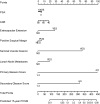Predicting 15-year prostate cancer specific mortality after radical prostatectomy
- PMID: 21239008
- PMCID: PMC4058776
- DOI: 10.1016/j.juro.2010.10.057
Predicting 15-year prostate cancer specific mortality after radical prostatectomy
Abstract
Purpose: Long-term prostate cancer specific mortality after radical prostatectomy is poorly defined in the era of widespread screening. An understanding of the treated natural history of screen detected cancers and the pathological risk factors for prostate cancer specific mortality are needed for treatment decision making.
Materials and methods: Using Fine and Gray competing risk regression analysis we modeled clinical and pathological data, and followup information on 11,521 patients treated with radical prostatectomy at a total of 4 academic centers from 1987 to 2005 to predict prostate cancer specific mortality. The model was validated on 12,389 patients treated at a separate institution during the same period. Median followup in the modeling and validation cohorts was 56 and 96 months, respectively.
Results: The overall 15-year prostate cancer specific mortality rate was 7%. Primary and secondary Gleason grade 4-5 (each p<0.001), seminal vesicle invasion (p<0.001) and surgery year (p=0.002) were significant predictors of prostate cancer specific mortality. A nomogram predicting 15-year prostate cancer specific mortality based on standard pathological parameters was accurate and discriminating with an externally validated concordance index of 0.92. When stratified by patient age at diagnosis, the 15-year prostate cancer specific mortality rate for pathological Gleason score 6 or less, 3+4, 4+3 and 8-10 was 0.2% to 1.2%, 4.2% to 6.5%, 6.6% to 11% and 26% to 37%, respectively. The 15-year prostate cancer specific mortality risk was 0.8% to 1.5%, 2.9% to 10%, 15% to 27% and 22% to 30% for organ confined cancer, extraprostatic extension, seminal vesicle invasion and lymph node metastasis, respectively. Only 3 of 9,557 patients with organ confined, pathological Gleason score 6 or less cancer died of prostate cancer.
Conclusions: Poorly differentiated cancer and seminal vesicle invasion are the prime determinants of prostate cancer specific mortality after radical prostatectomy. The prostate cancer specific mortality risk can be predicted with remarkable accuracy after the pathological features of prostate cancer are known.
Copyright © 2011 American Urological Association Education and Research, Inc. Published by Elsevier Inc. All rights reserved.
Figures




References
-
- Greene FL, Page DL, Fleming ID, et al. American Joint Committee on Cancer: AJCC Cancer Staging Manual. 6. New York: Springer-Verlag; 2002.

